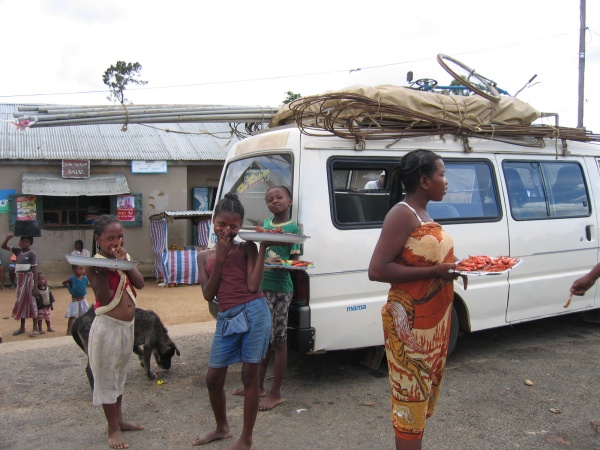Difference between revisions of "Taxi-brousse"
(Created page with 'Organised vans for transporting people and goods against a fee through the country of Madagascar are called taxi-brousse. Usually the taxi-brousse station can be found next to th...') |
CampMaster (talk | contribs) |
||
| (32 intermediate revisions by 8 users not shown) | |||
| Line 1: | Line 1: | ||
| − | Organised vans for transporting people and goods against a fee through the country of Madagascar are called taxi-brousse. Usually | + | '''Organised vans for transporting people and goods against a fee through the country of Madagascar are called taxi-brousse. Usually a taxi-brousse station can be found next to the market of the town.''' |
| − | + | Destinations and prices are written on the windscreen of each car. A fixed time table does not always exist, most taxi-brousse leave when the car is filled with passengers. Paying for empty seats can accelerate the departure to a considerable degree. At long-distance travels the driver will stop for a break at restaurants or street stands. | |
| − | + | [[File:Taxi-brousse_0001.jpg|600px|none|thumb|Taxi-brousse en-route [[Ilakaka]]]] | |
| + | |||
| + | Although the number of passengers depends on body volume, there seems to be no limit for goods. Everything what does not fit in the car, will be tied on the roof: large luggage, bicycles, sacks of rice or charcoal, furniture and chickens... | ||
| + | |||
| + | <HTML5video type="youtube">d2onl7UAlrs</HTML5video> | ||
| + | |||
| + | Many drivers mistake the ride with a rally and accidents are not uncommon. It is advisable to make sure the car ride is finished before dark on untarred roads. | ||
| + | |||
| + | An advantage in going by taxi-brousse is not only the low price, it is also getting to know the Malagasy people while sitting squeezed next to each other and listening to the preferred music channel of the driver. | ||
| + | |||
| + | [[File:Taxi-brousse_0002.jpg|600px|none|thumb|Fresh snacks served through the car window]] | ||
| + | |||
| + | <table cellpadding="0" cellspacing="0" border="0" style="margin-right:10px;"><tr> | ||
| + | <td valign="top">[[Image:Taxi-brousse_0003.jpg|189px|none|thumb|Taxi-brousse in [[Ramena]] Village]]</td> | ||
| + | <td valign="top">[[Image:Taxi-brousse_0004.jpg|189px|none|thumb|Goose on top!]]</td> | ||
| + | <td valign="top">[[Image:Taxi-brousse_0005.jpg|189px|none|thumb|Enjoying the ride]]</td></tr></table> | ||
| + | |||
| + | ---- | ||
| + | |||
| + | |||
| + | == Taxi-brousse stations in [[Antananarivo]] == | ||
| + | |||
| + | [[File:Taxi-brousse_0006.jpg|600px|none|thumb|City taxi-brousse in [[Antananarivo]]]] | ||
| + | |||
| + | * the eastern station in [[Ampasampito]] | ||
| + | * the northern station in [[Ambodivona]] | ||
| + | * the southern in Lalana Pastora Rahajason | ||
| + | * the western station a couple of hundred metres west of the southern station | ||
Latest revision as of 20:50, 30 March 2018
Organised vans for transporting people and goods against a fee through the country of Madagascar are called taxi-brousse. Usually a taxi-brousse station can be found next to the market of the town.
Destinations and prices are written on the windscreen of each car. A fixed time table does not always exist, most taxi-brousse leave when the car is filled with passengers. Paying for empty seats can accelerate the departure to a considerable degree. At long-distance travels the driver will stop for a break at restaurants or street stands.

Although the number of passengers depends on body volume, there seems to be no limit for goods. Everything what does not fit in the car, will be tied on the roof: large luggage, bicycles, sacks of rice or charcoal, furniture and chickens...
Many drivers mistake the ride with a rally and accidents are not uncommon. It is advisable to make sure the car ride is finished before dark on untarred roads.
An advantage in going by taxi-brousse is not only the low price, it is also getting to know the Malagasy people while sitting squeezed next to each other and listening to the preferred music channel of the driver.
 Taxi-brousse in Ramena Village |
Taxi-brousse stations in Antananarivo

- the eastern station in Ampasampito
- the northern station in Ambodivona
- the southern in Lalana Pastora Rahajason
- the western station a couple of hundred metres west of the southern station



